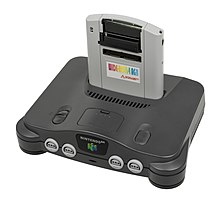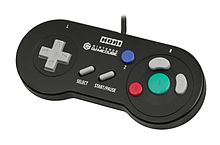 | |
 Game Boy Player under a GameCube | |
| Also known as | DOL-017 GBS (code name) |
|---|---|
| Manufacturer | Nintendo |
| Product family | GameCube |
| Type | Video game console add-on |
| Generation | Sixth |
| Release date |
|
| Media | |
| Predecessor | Super Game Boy |
| Related | GameCube |
The Game Boy Player[a] is a GameCube peripheral developed by Nintendo which enables it to play Game Boy, Game Boy Color, and Game Boy Advance cartridges, allowing those games to be played on a television.
It connects via the high speed parallel port at the bottom of the GameCube and requires use of a boot disc to access the hardware. Rather than emulating a Game Boy system, the Game Boy Player uses physical hardware nearly identical to that of a Game Boy Advance. The device does not use the enhanced effects used by the Super Game Boy (a similar peripheral for the Super Nintendo Entertainment System).[1] The peripheral received mainly positive reviews from critics.

The Game Boy Player is available in Indigo, Black, Spice, or Platinum in Japan; Black in North America and Europe[2] and Black and Indigo in Australia. A special Game Boy Player for the Panasonic Q (SH-GB10-H) was released because the Q's legs are oriented differently from the original GameCube's. All Game Boy Players have screws on the bottom to secure it to the bottom of the GameCube and also have an eject button on the right side of the unit for removing Game Boy Advance games. Game Boy and Game Boy Color games stick out from the unit, as with the Game Boy Advance and Game Boy Advance SP, so they can easily be taken out when the system is off or "Change Cartridge" has been selected from the menu.
Unlike some GameCube accessories, including the Advance Game Port,[3] Game Boy Player is not compatible with the Wii directly. The Wii lacks the hi-speed port of the GameCube into which the Game Boy Player fits; in addition, the Game Boy Player matches the GameCube's footprint. The Wii has a substantially different footprint, making direct compatibility too complicated to be included.
The Game Boy Player is region free, meaning the units will function on any GameCube system regardless of region, and like the Game Boy Advance, it will play cartridges of any region. However, the boot discs are region locked and must match the region of the GameCube system.
The Game Boy Player allows for control either through a GameCube controller or a Game Boy Advance or Game Boy Advance SP hooked up with a GameCube-Game Boy Advance Cable. When using a Game Boy Advance, the buttons are identical, but due to the GameCube controller's different layout, there are two different mappings players can use. Also, at least one GameCube controller must be plugged in for access to the Game Boy Player's internal menu, which can be accessed by pressing the Z button.
All controllers, Game Boy Advances, and Game Boy Advance SPs connected to the GameCube are recognized as the same player. This allows a sort of co-op mode for games that do not normally have it (this was most likely not intended by Nintendo). Furthermore, allowing for multiple controllers recognized as the same player allows for simpler and more comfortable play of single system multiplayer Game Boy Advance games, such as those found in Mario Party Advance, in lieu of up to four players holding one Game Boy Advance unit.
In order to link other hardware, players are required to connect to the extension port on the Game Boy Player with the proper cable, which depends on whether the game was designed for Game Boy Advance or a Game Boy system released before the Game Boy Advance.
| GameCube Button | GBA Equivalent - Map One | GBA Equivalent - Map Two |
|---|---|---|
| Control Stick/Directional Pad | Directional Pad | Directional Pad |
| A/B Buttons | A/B Buttons | A/B Buttons |
| L/R Buttons | L/R Buttons | Select |
| X/Y Buttons | Select | L/R Buttons |
| Start/Pause Button | Start Button | Start Button |
| C Stick | Not Used | Directional Pad |
| Z Button | Open Menu | Open Menu |
Map One is closer to the Game Boy Advance's normal layout, while Map Two makes it easier to play with one hand and also allows some SNES rereleases to control more like they may have with the SNES controller, as they often had the Y button mapped to L and the X button mapped to R.

Japanese hardware manufacturer Hori created for the Japanese market a special digital-only controller designed for use with the Game Boy Player. The design of the controller is similar to the design of the SNES controller, but with the GameCube's face button layout. In addition, there is a Select button on the controller mapped to the Y button internally.
The Game Boy Player supports the following:

The instruction manual for the Game Boy Player specifically mentions that "A few original Game Boy Game Paks may have display or sound problems," and that "Motion sensor [...], rumble feature and infrared feature Game Paks will not work with the Game Boy Player."[4] The following list concerns Game Boy Advance games and accessories that have compatibility issues, be they software or physical hardware, with the Game Boy Player:
The Game Boy Player added a rumble feature to certain Game Boy Advance games when played with a GameCube controller. Those games included:
Reception was mainly positive — many review sites cited how Nintendo effectively increased the GameCube's library by hundreds of games with the Game Boy Player, something that some reviewers praised[8] and others mocked as a cheap ploy.[9]
IGN mentioned that the filtering that the Game Boy Player uses (to relieve strobe effect on games using a flicker trick to make sprites seem transparent) "muddies" some of the graphics.[10]
Datel's version of the Game Boy Player was released in 2003.[11] This dongle connects to Memory Card Slot B and can be booted up with the included boot disc. Later models have code generators for built in cheat devices.[12] The advantage is that no removal of plates on the bottom, nor tools, are needed to install it. Unlike the Game Boy Player, the Advance Game Port utilizes software emulation, causing numerous audio and video issues in many games.[13]
Up until System Menu 3.0's release, and later the dawn of Wii homebrew, this was also the only way of running Game Boy Advance games on the Wii — because, as the Wii lacks the correct port, the Game Boy Player cannot be used. Before System Menu 3.0, the Wii allowed unofficial GameCube software, such as this and Action Replay. As the dongle plugs into the Memory Card Slot, it was fully compatible with the Wii.[3] System Menu 3.0 prevented unofficial GameCube software from running, rendering this unusable. With the dawn of Wii homebrew, it is now possible to run the Game Boy lineup of games via an emulator.